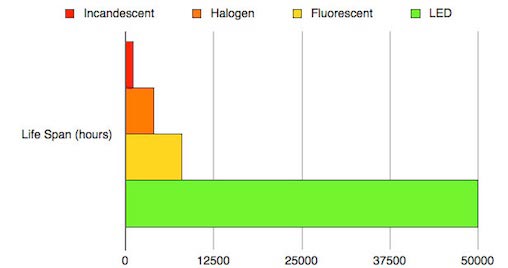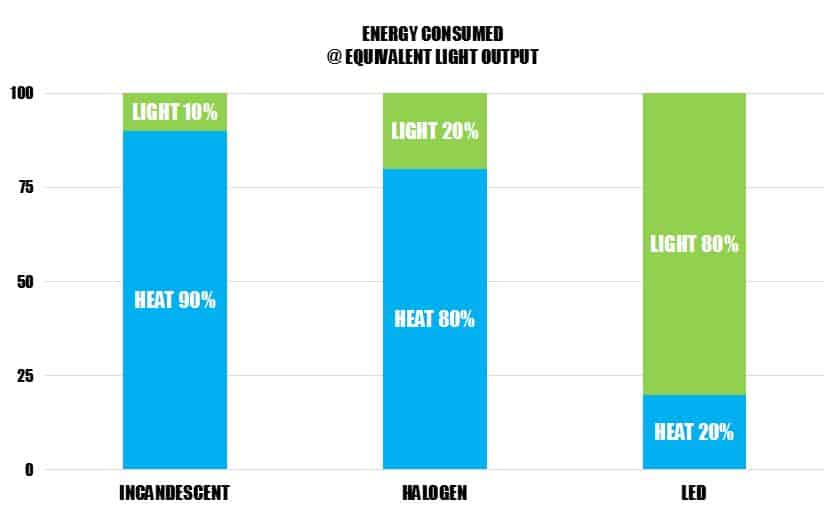To understand which is the best lighting technology (between LED lighting and incandescent lighting), you must first understand the advantages and disadvantages of each. Below is a look at the advantages and drawbacks of LED lights.
LEDs are one of the most energy efficient sources of lighting. They draw a very small amount of power and they have a high light output (up to 135 lumens per watt). Unlike other lighting sources (CFL and incandescent lights), LED lights also produce very little heat, and thus nearly all the power they draw is converted into light. On top of that, LED lights have a directional lighting capability, which helps to reduce light and energy wastage.
Unlike conventional lighting, LEDs do not burn or fail, instead, they dim over time. Quality lifetime can, therefore, last for a long time, some up to 50,000 hours. While the LED bulb you buy might not achieve such a long lifespan, you can be sure that it will last longer than incandescent bulbs, which burn out after around 1,000 hours.
 Lifespan of LED vs incandescent
Lifespan of LED vs incandescentLED light bulbs are very durable. Their internal components are not delicate (there are no filaments) and thus they are resistant to breakage, vibrations, and even impacts. The design of LEDs also makes them more durable – they do not use glass or quartz on the interior and they are mounted and soldered on a circuit board.
One of the main drawbacks of traditional light bulbs is that they do not produce the full amount of light the moment they are switched on; they require a few minutes to warm up and reach maximum brightness. While this might not be an issue in some situations, it can become very problematic in situations where the lights are being switched on and constantly. However, with LED lights, you never have to worry about this. Once they are switched on, they will reach maximum brightness instantly.
One of the most amazing benefits of LED lights is that they can be operated in low temperatures. In fact, unlike other types of lights, the performance of LEDs increases as the temperature decreases. LED lights are thus ideal for freezers, cold storage rooms, refrigerated display cases, parking lots, building perimeters, and other areas where temperatures can get very low.
In addition to being operated at cold temperatures, LED lights do not emit heat through infra-red radiation. Therefore, LED lights are very cool to the touch, which minimizes the risk of burn accidents. The fact that LEDs do not emit heat also makes them ideal for places that need to be kept cool, for example, cold storage rooms, freezers, and refrigerators, food processing facilities, etc. LEDs are also perfect for textile factories and exhibit rooms, where infra-red radiation can degrade the quality or writings of fabrics.
 Energy Consumed of LED vs Incandescent
Energy Consumed of LED vs IncandescentLEDs do not contain mercury or other toxic chemical substances that are used in the manufacture of conventional light fixtures. They also don’t emit UV radiation, which is not only harmful to the environment but can also be toxic to human beings. Therefore, LED lighting technology is the top environmental friendly lighting technologies, as LED lighting fixtures cause minimal to no harm to the environment when they are disposed of.
Another thing that makes LED light fixtures environmental friendly is the fact that they come with designs that are easy to recycle. Therefore, instead of throwing them away, you can recycle LED light fixtures and reduce the damage caused to the environment.
Another amazing benefit of LED lights is that they are controllable, at an affordable price. While it would take several hundred dollars and a lot of design work to make conventional light fixtures controllable, LED lights can be easily controlled. For example, LED light fixtures can be connected to lighting control system, which can allow you to control the level of brightness they offer, the color of the light, when they come on or off, etc.
Perhaps the top benefit of LED lights is that they are very cost-effective in the long term. To start with, LEDs are very energy efficient, using up to 70% less energy compared to other conventional light fixtures. As a result, when you are using LED lights, you can expect your power bills to be significantly lower.
LED lights also have a long lifespan, which means that they rarely get changed. Therefore, when you switch to LEDs, you can expect to spend very little money on the replacement costs of the lighting fixtures. In addition, LED light fixtures to have fewer replacement costs, LED lights to have minimal replacement costs, as they are very durable and resistant to breakage and impact.
Therefore, in the long run, you will end up spending significantly less on LED light fixtures that you would have if you were using conventional light fixtures. This makes them ideal for large premises, for example, factories, warehouses, workshops, learning institutions, hospitals, and others as they help to reduce the operational costs of these facilities.
Copyright © All Right Reserved 浙ICP备15016532号
BY:
